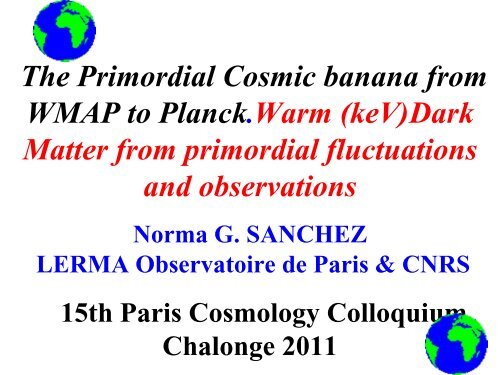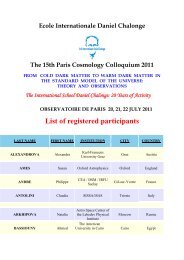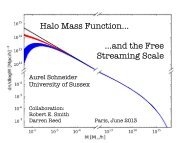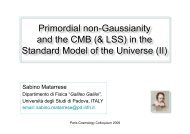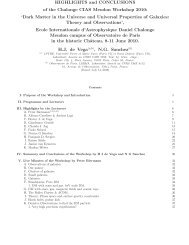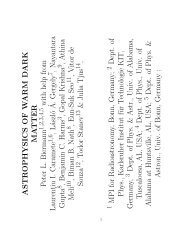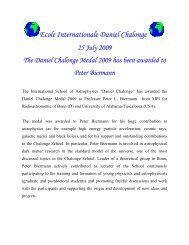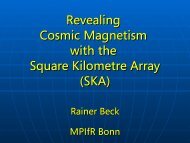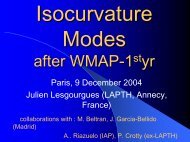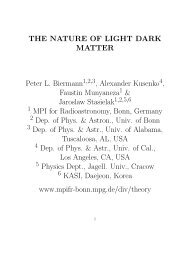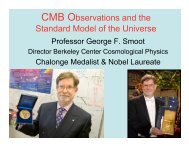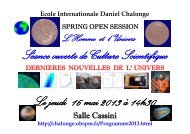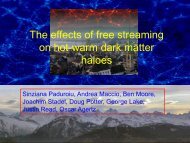Norma G.SANCHEZ (.pdf)
Norma G.SANCHEZ (.pdf)
Norma G.SANCHEZ (.pdf)
You also want an ePaper? Increase the reach of your titles
YUMPU automatically turns print PDFs into web optimized ePapers that Google loves.
The Primordial Cosmic banana from<br />
WMAP to Planck.Warm (keV)Dark<br />
Matter from primordial fluctuations<br />
and observations<br />
<strong>Norma</strong> G. <strong>SANCHEZ</strong><br />
LERMA Observatoire de Paris & CNRS<br />
15th Paris Cosmology Colloquium<br />
Chalonge 2011
CONTENTS<br />
(0)The Standard Model of the Universe Includes Inflation<br />
(I) LATEST PREDICTIONS 2010 & 2011:<br />
The Universal Cosmic Banana: non-zero amount of<br />
primordial gravitons And Forecasts for Planck<br />
(II) : DARK MATTER IN GALAXIES from<br />
Theory and Observations: Warm (keV scale) dark matter<br />
(III) GALAXY DENSITY PROFILES, UNIVERSAL<br />
GALAXY PROPERTIES and SURFACE DENSITY<br />
Analytical Results<br />
and Numerical (including analytical) Results
H de Vega, C Destri, NG. Sanchez :<br />
« MCMC analysis of WMAP3 and SDSS data points to broken<br />
symmetry inflaton potentials and provides a lower bound on<br />
the tensor to scalar ratio”, Phys. Rev. D77, 043509 (2008)<br />
« Higher order terms in the inflaton potential and the lower<br />
bound on the tensor to scalar ratio r”Annals Phys 326, 578 (2011)<br />
D. Boyanovsky, C. Destri, H. de Vega, N.G.Sanchez<br />
“The Effective Theory of Inflation in the Standard Model of the<br />
Universe and the CMB+LSS data analysis “<br />
Int. J. Mod. Phys. A. 24, 3669-3864 (2009)<br />
C. Burigana, C. Destri, H. de Vega, A. Gruppuso, N. Mandolesi, P.<br />
Natoli, N.G. Sanchez « Forecast for the Planck precision on the<br />
tensor to scalar ratio and other cosmological parameters”<br />
APJ 724 , 588-607 (2010)
LOWER BOUND on r<br />
THE PRIMORDIAL GRAVITONS<br />
Our theory input (Effective Theory Inflation) in the<br />
MCMC data analysis of WMAP5+LSS+SN data).<br />
C. Destri, H J de Vega, N G Sanchez, Phys Rev D77,<br />
043509 (2008) shows:<br />
Besides the upper bound for r (tensor to scalar<br />
ratio) r < 0.22, we find a clear peak in the r<br />
distribution and we obtain a lower bound<br />
r > 0.023 at 95% CL and<br />
r > 0.046 at 68% CL.<br />
Moreover,we find r = 0.051 the most probable value<br />
For the other cosmological parameters, both analysis agree.
THE PRIMORDIAL COSMIC BANANA<br />
The tensor to scalar ratio r (primordial gravitons) versus the<br />
scalar spectral index n_s. The amount of r is always non zero<br />
H.J. de Vega, C. Destri, N.G. Sanchez, Annals Phys 326, 578(2011)
PREDICTIONS From the cosmic banana:<br />
UPPER BOUND r < 0.053<br />
LOWER BOUND r > 0.021<br />
0.021 < r < 0.053<br />
Most probable value: r ~ 0.051<br />
--------------------<br />
FORECASTS FOR PLANCK<br />
With Fiducial r = 0.0427 •<br />
with<br />
the<br />
We<br />
found<br />
for r at<br />
95% CL:<br />
0.028 < r < 0.116<br />
best values r = 0.04, nS= 0.9608<br />
C. Burigana, C. Destri, H.J. de Vega, A.Gruppuso, N.<br />
Mandolesi, P. Natoli, N. G. Sanchez :<br />
ApJ 724, 588-607 (2010)
OUR FORECAST for PLANCK<br />
0.028 < r < 0.116 95 % CL ,<br />
best value r = 0.04 n s = 0.9608<br />
Supports searching of CMB B-mode polarization<br />
in the current data as well as the planned CMB<br />
polarization missions<br />
�Forecasted B mode detection probability by the<br />
most sensitive HFI-143 channel:<br />
�For a 95% CL detection the level of<br />
foreground residual should be reduced to 10% or<br />
lower of the adopted toy model. �Borderline
Dark Matter: from primordial<br />
fluctuations to Galaxies<br />
� Cold (CDM): small velocity dispersion: small structures form<br />
first, bottom-up hierarchical growth formation, too heavy (GeV)<br />
�Hot (HDM) : large velocity dispersion: big structures form first,<br />
top-down, fragmentation, ruled out , too light (eV)<br />
Warm (WDM): ``in between’’<br />
(keV)<br />
CDM<br />
Problems:<br />
ΛWDM Concordance Model:<br />
CMB + LSS + SSS Observations<br />
DM is WARM and COLLISIONLESS<br />
� ``clumpy halo problem’’, large number of satellite galaxies<br />
“satellite problem”<br />
� ρ (r) ~ 1 / r (cusp)<br />
� And other problems…..
THE MASS OF THE<br />
DARK MATTER PARTICLE
MASS OF THE DARK MATTER PARTICLE<br />
H. J. De Vega, N.G. Sanchez Model independent analysis of dark matter<br />
points to a particle mass at the keV scale Mon. Not. R. Astron. Soc.<br />
404, 885 (2010)<br />
D. Boyanovsky, H. J. de Vega, N.G. Sanchez Constraints on dark matter<br />
particles from theory, galaxy observations and N-body simulations<br />
Phys.Rev. D77 043518, (2008)<br />
BOLTZMAN VLASOV EQUATION, TRANSFERT FUNCTION<br />
D. Boyanovsky, H. J. de Vega, N.G. Sanchez The dark matter transfer<br />
function: free streaming, particle statistics and memory of<br />
gravitational clustering Phys. Rev. D78: 063546, (2008)<br />
DENSITY PROFILES, SURFACE DENSITY, DARK MATTER<br />
PARTICLE MASS<br />
H. J. de Vega, N.G. Sanchez Gravity surface density and density profile<br />
of dark matter galaxies IJMPA26:1057 (2011)<br />
H. J. de Vega, P. Salucci, N.G. Sanchez<br />
Universal galaxy properties and<br />
the mass of the dark matter particle from theory and observations:<br />
the power of the linear approximation arXiv:1004.1908
�Compute from the distribution function of dark<br />
matter particles with their different statistics,<br />
physical magnitudes as :<br />
-the<br />
-the<br />
-the<br />
dark<br />
dark<br />
dark<br />
matter<br />
matter<br />
matter<br />
energy<br />
velocity<br />
density<br />
density<br />
ρ<br />
dispersion σ<br />
in the<br />
DM(z)<br />
,<br />
phase space<br />
DM(z),<br />
D(z)<br />
� Confront to their values observed today (z = 0).<br />
�� From them, the mass m of the dark matter<br />
particle and its decoupling temperature T d are<br />
obtained.<br />
The phase-space density todayisa factor Z smaller than its<br />
primordial value. The decreasing factor Z > 1 is due to the<br />
effect of self-gravity interactions: the range of Z is computed.
OBSERVATIONS<br />
The observed dark matter energy density observed<br />
today has the value ρ = 0.228 (2.518 meV) 4 .<br />
DM<br />
In addition, compilation of galaxy observations yield<br />
the one dimensional velocity dispersion σ and the<br />
radius L in the ranges<br />
6.6 km/s ≤<br />
σ<br />
≤<br />
11.1 km/s , 0.5 kpc<br />
And the Phase-space Density today<br />
of a factor 10) has the value :<br />
D(0) ~ 5 ×<br />
10 3<br />
[keV/cm 3 ] (km/s) -3<br />
≤<br />
(with<br />
L ≤<br />
1.8 kpc<br />
a precision<br />
= (0.18 keV) 4<br />
.
�Compilation of observations of galaxies<br />
candidates for DM structure, are compatible with a<br />
core of smooth central density and a low mean mass<br />
density ~ 0.1 Msun /pc 3 rather than with a cusp.<br />
�Dark matter particles can decouple being<br />
ultrarelativistic or non-relativistic. Dark matter must<br />
be non-relativistic during structure formation in<br />
order to reproduce the observed small structure at<br />
~ 2 − 3 kpc.<br />
�In addition, the decoupling can occurs at local<br />
thermal equilibrium or out of local thermal<br />
equilibrium. All these cases have been considered in<br />
our analysis.
(i)<br />
the<br />
RESULTS on DARK MATTER :<br />
mass of the dark matter particle<br />
is 100 GeV at least.<br />
scale,T d<br />
is<br />
in the<br />
keV<br />
(ii) The free-streaming length todayisin thekpc<br />
range, consistent with the observed small scale<br />
structure and the Jean’s mass is in the range of<br />
the galactic masses, 1012 Msun. (iii) Dark matter self-interactions<br />
are negligible.<br />
(other<br />
than<br />
grav.)<br />
(iv) The keV scale mass dark matter determines<br />
cored (non cusped) dark matter halos.<br />
(v) DM candidates with typical high masses 100 GeV<br />
(”wimps”) result strongly disfavored.
keV SCALE DARK MATTER PARTICLES<br />
REPRODUCE:<br />
�OBSERVED GALAXY DENSITIES<br />
AND VELOCITY DISPERSIONS<br />
�OBSERVED GALAXY DENSITY PROFILES<br />
->OBSERVED SURFACE DENSITY VALUES OF<br />
DARK MATTER DOMINATED GALAXIES
•<br />
The comoving<br />
wavelength, ie<br />
Jeans’<br />
(free-streaming)<br />
the largest wavevector<br />
gravitational instability , and the<br />
smallest unstable mass by gravitational<br />
obtained in the range<br />
• These<br />
small<br />
0.76 kpc<br />
0.45 10 3<br />
Jeans’<br />
exhibiting<br />
mass (the<br />
collapse) are<br />
/ (√1 + z) < λfs(z) < 16.3 kpc<br />
M sun<br />
< M J<br />
(z) (1 + z) -3/2 < 0.45 10 7<br />
values at z = 0 are consistent and of order<br />
dark matter structures observed today .<br />
/ (√1 + z)<br />
M sun<br />
of the<br />
• By the beginning of the matter dominated era z ~ 3200,<br />
the masses are of the order of galactic masses 1012 Msun and the comoving free-streaming length is of the order of<br />
the galaxy sizes today ~ 100 kpc
The free-streaming wavelength today in kpc vs. the dark matter particle mass in<br />
keV. It decreases for increasing mass m and shows little variation with the particle
• The mass of the dark matter particle,<br />
independent of the particle model, is in the keV<br />
scale and the temperature when the dark<br />
matter particles decoupled is in the 100 GeV<br />
scale at least.<br />
Robust result. No assumption about the particle<br />
physics model of the dark matter particle.<br />
keV DM mass much larger than temperature in<br />
matter dominated era (which is less than 1 eV)<br />
m and Td are mildly affected by the uncertainty in<br />
the factor Z through a power factor 1/4 of this<br />
uncertainty, namely, by a factor 10 1/4 ~ 1.8.
• Lower<br />
and<br />
upper<br />
bounds<br />
for the<br />
dark<br />
matter<br />
annihilation cross-section σ0 are derived: σ0 > (0.239 −<br />
0.956) 10−9 GeV−2 and σ0 < 3200 m GeV−3 . There is at least<br />
five orders of magnitude between them ,<br />
gravitational<br />
self-interaction is<br />
the dark<br />
negligible<br />
matter<br />
non<br />
(consistent with<br />
structure formation and observations, X-ray, optical and lensing<br />
observations of the merging of galaxy clusters).<br />
•<br />
Typical ”wimps” (weakly interacting massive particles)<br />
with mass m = 100 GeV and Td = 5 GeV would require a<br />
huge Z ~ 1023 , well above the upper bounds obtained and<br />
cannot reproduce the observed galaxy properties.<br />
Wimps produce extremely short free-streaming or Jeans<br />
length today λfs (0) = 3.51 10−4 pc = 72.4 AU that would<br />
correspond to unobserved structures much smaller than<br />
the galaxy structure. Wimps result strongly disfavoured.<br />
[TOO cold]
In all cases: DM particles decoupling either ultrarelativistic<br />
or non-relativistic, LTE or OTE :<br />
(i)<br />
the mass of the dark matter particle<br />
keV is 100 GeV at least.<br />
(ii) The<br />
kpc<br />
scale,T d<br />
free-streaming<br />
length<br />
is<br />
todayisin the<br />
in the<br />
range, consistent with the observed small<br />
scale structure and the Jean’s mass is in the range<br />
of the galactic masses, 1012 .<br />
M sun<br />
(iii) Dark matter self-interactions<br />
grav.) are negligible.<br />
(other<br />
than<br />
(iv) The keV scale mass dark matter determines<br />
cored (non cusped) dark matter halos.<br />
(v) DM candidates with typical high masses 100<br />
GeV (”wimps” ) result strongly disfavored.
endobj
WDM vs CDM linear fluctuations Today<br />
Destri, de Vega Sanchez, in preparation
keV<br />
SCALE DARK MATTER PARTICLES<br />
REPRODUCE:<br />
�OBSERVED GALAXY DENSITIES<br />
AND VELOCITY DISPERSIONS<br />
�OBSERVED GALAXY DENSITY PROFILES<br />
�OBSERVED SURFACE DENSITY VALUES<br />
OF DARK MATTER DOMINATED GALAXIES
[ DARK MATTER : FACTS AND STATUS<br />
� DARK MATTER DOES EXIST<br />
� ASTROPHYSICAL OBSERVATIONS POINTS TO THE<br />
EXISTENCE OF DARK MATTER<br />
� AFTER MORE THAN TWENTY YEARS OF DEDICATED<br />
DARK MATTER PARTICLE EXPERIMENTS, THE DIRECT<br />
SEARCH OF DARK MATTER PARTICLES FULLY<br />
CONCENTRATED IN “GeV WIMPS” REVEALED SO FAR,<br />
UNSUCCEFULL. BUT DARK MATTER DOES EXIST<br />
IN DESPITE OF THAT: PROPOSALS TO REPLACE<br />
DARK MATTER DID APPEARED:<br />
PROPOSING TO CHANGE THE LAWS OF<br />
PHYSICS (!!!), ADDING OVER CONFUSION,<br />
MIXING , POLLUTION...
TODAY, THE DARK MATTER RESEARCH AND DIRECT<br />
SEARCH SEEMS TO SPLIT IN THREE SETS:<br />
(1). PARTICLE PHYSICS DARK MATTER: PARTICLE BUILDING<br />
MODELS, DEDICATED LAB EXPERIMENTS, ANNHILATING DARK<br />
MATTER, (FULLY CONCENTRATED ON “GeV WIMPS”)<br />
(2).<br />
ASTROPHYSICAL DARK MATTER: (ASTROPHYSICAL<br />
MODELS, ASTROPHYSICAL OBSERVATIONS)<br />
(3).<br />
NUMERICAL SIMULATIONS<br />
(1) and (2) DO NOT AGREE IN THE RESULTS<br />
and (2) and (3) DO NOT FULLY AGREE NEITHER<br />
SOMETHING IS GOING WRONG IN THE RESEARCH ON THE<br />
DARK MATTER<br />
WHAT IS GOING WRONG ?, [AND WHY IS GOING WRONG]
THE SUBJECT IS MATURE<br />
� THERE EXIST ASTRONOMICAL OBSERVATIONS AND FACILITIES<br />
� THERE EXIST MODEL /THEORETICAL ASTROPHYSICAL RESULTS<br />
WHICH FIT, AGREE WITH THE ASTRONOMICAL OBSERVATIONS<br />
� THERE EXISTED,THERE EXIST MANY DARK MATTER<br />
DEDICATED PARTICLE EXPERIMENTS<br />
(ALTHOUGH FULLY CONCENTRATED IN “GeV WIMPS”)<br />
� THERE EXIST COMPUTER AND SUPER COMPUTERS AND DIFFERENT<br />
RESEARCHER GROUPS PERFORMING WORK WITH THEM<br />
“<br />
� THERE EXIST A CONSIDERABLE AMOUNT OF RESEARCHERS<br />
WORKING IN DARK MATTER DURING MORE THAN TWENTY YEARS<br />
FUITE EN AVANT”<br />
(“ESCAPE TO THE FUTURE”) IS NOT THE ISSUE<br />
WHAT IS WRONG in the present day subject of Dark Matter?,<br />
(The Answer is Trivial and can be found in these 3 slides) ]
DM Dark Matter research<br />
• Present CDM status: Always increasing amount of<br />
confusion in the CDM research in the last 20 years ,<br />
namely the increasing number and ciclic changing of<br />
arguments and counter-arguments and ad-hoc<br />
mechanisms introduced in CDM simulations over most of<br />
twenty years, in trying to deal with the CDM small scale<br />
problems, without really having a physical first principle<br />
derivation or control of such invoked mechanisms for the<br />
purpose (“adiabatic contraction”, non circular motions,<br />
triaxiality, mergers, baryon feedbacks, strippings,,...”, ...)<br />
•
(C)DM research: present status<br />
• On the CDM particle side, the problems are no less critical:<br />
So far, all the dedicated experimental searches after most of<br />
twenty years to find the theoretically proposed CDM<br />
particle candidats (Wimps) have failed.<br />
• Its indirect search (invoking “CDM annihilation”) to<br />
explain cosmic rays positron excess, is in crisis as well, as<br />
wimps annihilation models are plugged with increasing<br />
tailoring or fine tuning, and such cosmic rays excesses are<br />
well explained and reproduced naturally by natural<br />
astrophysical process.<br />
• The so-called and repeatedly invoked "`wimp miracle" is<br />
nothing but one equation with three constraints,<br />
theoretically motivated by SUSY model building.
Summary<br />
(3)<br />
(Pasquale<br />
BLASI, here<br />
on Wednesday)<br />
THIS IS ESPECIALLY TO BE KEPT IN MIND WHEN<br />
INVOKING UNCONVENTIONAL EXPLANATIONS, SUCH<br />
AS THOSE BASED ON COLD DARK MATTER<br />
ANNIHILATION<br />
THE DM HYPOTHESIS FOR THE POSITRON EXCESS<br />
WAS NOT THE MOST NATURAL - THE SIGNAL FROM<br />
WIMPS IS NATURALLY TOO SMALL<br />
BUT THE THEORY WAS CONTRIVE (LEPTOPHILIC DM,<br />
BOOST FACTORS,<br />
SOMMERFIELD ENHANCEMENT) FOR THE SOLE<br />
PURPOSE OF FITTING ONE SET OF DATA (THE<br />
POSITRON FRACTION AND THE ABSENCE OF<br />
ANTIPROTON ANOMALIES).
(C)DM research: present status<br />
• The community engaged in CDM simulations and the<br />
super- computers is large, as well as the experimental<br />
particle physics wimp community, involving big budgets,<br />
(and large number of people), it could not then a rapid<br />
turning point which could be expected yet in the CDM<br />
research community.....<br />
• Still, the situation is changing rapidly in the scientific WDM<br />
research, (simply because the subject is new and WDM<br />
(essentially) works….<br />
• Wimp experiments will not find the DM particle …..<br />
• LHC will not find the DM particle …..<br />
• Simply because they are searching at the wrong DM mass<br />
scale<br />
• The DM particle is at the keV scale
%PDF-1.6
%âãÏÓ
END<br />
THANK YOU<br />
FOR YOUR ATTENTION


